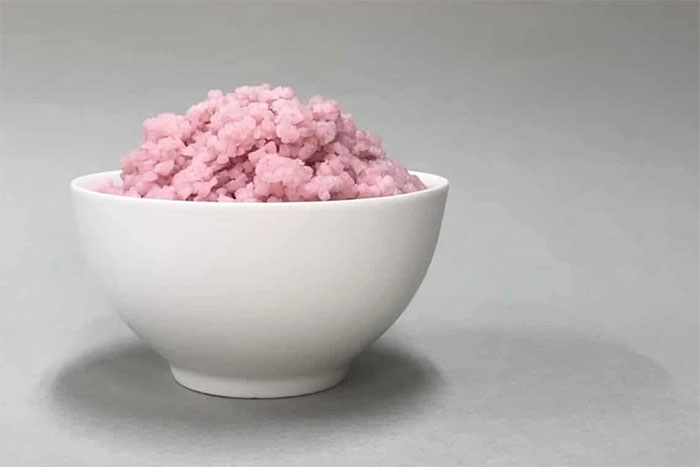Beef-rice hybrid: Sustainable food promises to replace meat in the future
Korean researchers have created beef rice for the first time by growing beef skeletal muscle and fat stem cells in rice grains .
This new food is more nutritious than regular rice grains, and reduces the risk of allergies compared to other synthetic meats.

Beef hybrid rice is pink, contains many nutrients and is environmentally friendly. (Illustration photo: Yonsei University).
In particular, it could constitute an alternative source of protein that is both affordable and has a lower carbon footprint than beef.
The current climate crisis requires countries to transform their food production systems.
Food production - from farming to livestock to consumption - is one of the largest sources of carbon emissions worldwide.
Beef is particularly notable for its heavy impact on the environment, emitting nearly 50kg of CO 2 per 100 grams of protein.
Environmental pressure on the food production sector is increasing as the world's population grows. This will lead to a global food crisis, if there is no sustainable agricultural system.
Many alternative protein sources are being researched for this purpose, such as proteins derived from insects, algae and cultured meat.
However, the solutions proposed to date still have many limitations in terms of reproducibility, taste, nutritional value, price competitiveness and reduced environmental impact.
Hybrid foods , which include both plant and animal ingredients, show great potential for sustainable, healthy and affordable diets.
In this context, researchers from Yonsei University, Korea developed a beef-rice hybrid that contains all these benefits.
Researcher Sohyeon Park, Yonsei University shared: "Imagine that we receive all the necessary nutrients from beef-hybrid rice. Rice already contains high levels of nutrients, but adding more Cells from livestock can increase these nutritional values."
Reduces the risk of allergies, improves taste and reduces carbon emissions
In complex organisms, the biological environment supports cell growth to form three-dimensional tissues and organs.

Beef hybrid rice is made from beef muscle and fat stem cells. (Photo: Yonsei University).
To grow meat, Yonsei researchers simulated this environment using rice. Rice grains have a porous structure, serving as an environment for the growth of cow cells.
On the other hand, rice contains essential nutrients such as carbohydrates, lipids and (plant) proteins, as well as minerals such as phosphorus, calcium and magnesium.
It also contains functional nutrients, such as glutelin and folic acid, which play essential roles in the metabolic activity of skeletal muscle cells.
In cell culture medium, rice grains act as a nutritional substrate that promotes cell proliferation.
In addition, rice is an ingredient with a lower allergy rate. This is important for growing artificial meat, which can also be made from soybeans or other seeds. However, they are common allergens.
In addition, artificial meat is only compatible with a limited number of cell types, forcing scientists to use many additives to flavor the product.
Korean researchers used both skeletal muscle cells and fat cells to best recreate the taste, texture and nutritional value of natural meat.
To do this, they coated the rice grains with fish gelatin - an edible and healthy ingredient - that allowed the cells to adhere to the rice grains better. Enzymes have also been added to stimulate cell proliferation.
Then, beef fat and muscle stem cells are put into rice grains and cultured for 9 to 11 days.
"I did not expect cells to grow so well in rice grains ," said Sohyeon Park, lead author of the study.
According to the research team, the final product perfectly meets the requirements for food safety and nutrition standards.
To describe the characteristics of beef rice, scientists steamed and analyzed the nutritional value, aroma emitted and texture from this hybrid beef rice.
Results showed that it contained 8% more protein and 7% more fat than regular rice.
In terms of texture, rice is pink, firmer and crispier after cooking . The higher muscle cell content gives it the delicate aroma of cooked beef and almonds, while the lipids give the rice the aroma of butter and coconut oil.
Furthermore, the production of the beef-rice hybrid emits less than 6.27 kg of CO 2 per 100 grams, roughly equivalent to the carbon footprint of chicken.
If sold on the market, it would cost about $2.23/kg, compared to $14.88/kg for beef.
However, before this product can be commercialized, the team of scientists plans to research better growing conditions to increase the nutritional value of the product.
"This research shows that we have a lot of potential to produce hybrid foods from cereals . One day, this could be used as famine relief food, rations for military or even food for space ," Sohyeon Park concluded.
- The yield of Vietnamese hybrid rice is 15-20% higher than pure rice.
- Startup Israel declared to make artificial steak, costing 50 USD / piece, tastes like real cow
- The surprising fact about the piece of meat for 15 years is still sold for 73 million
- Why do hybrid rice have to breed every year?
- In the future, we can eat seaweed instead of animal meat
- Without rice, what will humans eat?
- How to choose delicious meats to ensure food safety
- Artificial meat $ 330,000 to the oven
- For the first time there was a banquet with artificial meat
- Coming soon the world's first cheap artificial beef cake
- Why are beef steaks glowing in rainbow colors?
- Beef eat grass better for you?
 Why do potatoes have eyes?
Why do potatoes have eyes? 'Tragedy' the world's largest carnivorous life: Death becomes ... public toilet
'Tragedy' the world's largest carnivorous life: Death becomes ... public toilet Tomatoes were once considered 'poisonous' for 200 years
Tomatoes were once considered 'poisonous' for 200 years Detecting microscopic parasites on human face
Detecting microscopic parasites on human face